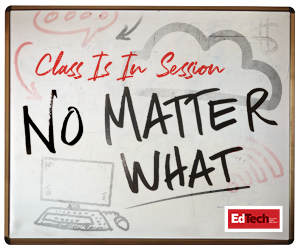1. Understand What Blended Learning Is — and Isn’t
Instructors new to blended learning often take existing face-to-face courses and simply add online activities. The problem, says Thompson, is that this often results in a workload of essentially two courses, or a course and a half. It can also lead to online assignments that resemble busywork, or at least they may be perceived that way by students.
Better, he says, is to think of face-to-face activities as enhancing an online course, not the other way around.
“The best way to go about blended design is to fully redesign a course for online, then step back and ask: Where could key, strategic, face-to-face experiences be extremely helpful?” he says.
For instance, learning opportunities that are challenging to replicate online — such as active learning or group work — can be a purposeful use of in-person time, says Lauren Bruzga, a curriculum and design specialist at the University of Buffalo’s Center for Educational Innovation.
MORE ON EDTECH: Learn how data analytics will help campuses reopen safely.
2. Strive to Create an Integrated Learning Experience
According to Thompson, effectively integrating online and face-to-face elements is one of the biggest challenges for many faculty. “What you want is a seamless experience,” he says.
Often, he says, instructors find it easy to think of classroom activities but have a harder time identifying strategies that work online or that combine the two spaces — for instance, a discussion that starts in the classroom and continues online, or vice versa.
Those intersections are important, Thompson says. Done well, they allow instructors to tap into the strengths of both channels and combine them in complementary ways.
Where it makes sense, instructors might take their own strengths into account, Thompson says. An instructor who excels at engaging students in discussions might make that a priority for in-person meetings, for example, and focus online sessions on content delivery.
MORE ON EDTECH: Learn how to promote online access with hotspots, laptops, and planning.
3. From Technology to Communication, Put the Right Tools in Place
The IT foundation includes a high-quality learning management system, video recording technology and applications, videoconferencing software and institution-specific software. Most LMSs have robust features that support core activities, such as sharing content, embedding videos, submitting and grading assignments, posting announcements and posting in forms, and they often support third-party integrations.
Yet this robustness can be a double-edged sword, Bruzga says.
“Often faculty are unaware of — or overwhelmed by — the vast options within an LMS’s capabilities,” she says. “Educational technologists and instructional designers can support faculty by choosing and utilizing tools to best meet the needs of their programs, courses and students.”
Video can give instructors an engaging way to communicate with students — for instance, to answer FAQs or elaborate on a concept discussed in class, Bruzga says. Videoconferencing, frequently delivered via Zoom, Skype or Webex, supports synchronous sessions and faculty office hours.
Communication is also essential. Before a course starts, instructors should determine which sessions will be online and in person and include those details in the syllabus, Bruzga says. When synchronous and asynchronous learning are combined, students need to know their options and obligations for attendance and assignments.
MORE ON EDTECH: Learn how to increase college success for underserved students.
4. Be Mindful of Inclusion and Iteration in Blended Learning Design
Blended learning tools should address access, inclusivity and privacy concerns, Bruzga says.
That means considering students’ access to required or recommended tools and, where needed, strategies such as equipment loans and course accommodations. To ensure courses are inclusive of all learners, Bruzga recommends that colleges look to Universal Design for Learning principles and create opportunities for autonomy, individual interests and learner preferences.
Instructors benefit from periodic opportunities to evaluate and improve their courses — for example, through student assessments and feedback, Bruzga says. She encourages instructors to collaborate not only with teaching peers but also with instructional designers, educational technologists and IT staff.
UCF’s Blended Learning Toolkit, created in partnership with the American Association of State Colleges and Universities, is a free, comprehensive resource for colleges seeking to develop or expand blended learning programs.
Thompson, who sees blended learning as the future of education, says hybrid instruction represents a wealth of opportunities for teaching and learning — perhaps more than people realize.
“It’s like colors on an artist’s palette that you can draw from,” he says.











